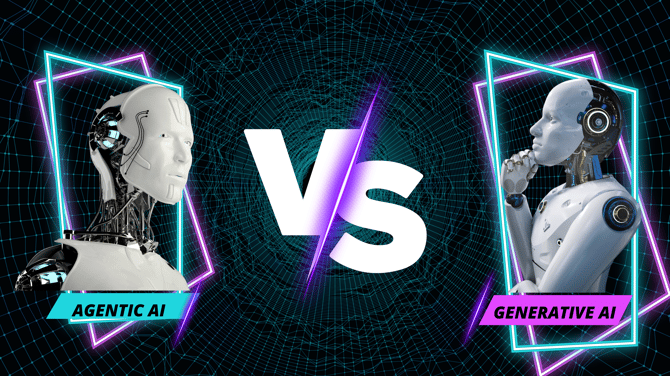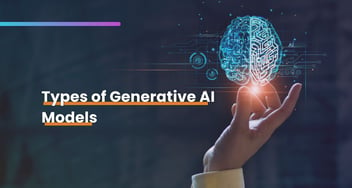Agentic AI vs Generative AI: Choosing the Right AI for Your Business
Explore the differences between Agentic AI and Generative AI, their core strengths, and real-world business applications. Understand how Agentic AI drives autonomous decisions while Generative AI powers creativity, and get practical guidance on choosing the right AI for your business growth.

Artificial intelligence has officially moved from “future promise” to a daily business tool. In 2025, every business(small, medium or large enterprises) are opting for AI tools to reduce costs, streamline their operations and sharpen their competitive edge.
What’s most encouraging is the optimism among SMB leaders: nearly four in ten owners see AI not as a threat to jobs but as a catalyst for creating new roles and opportunities within their companies.
 Generate
Key Takeaways
Generating...
Generate
Key Takeaways
Generating...

- Generative AI is a creative helper: great for content, marketing, and ideation.
- Agentic AI is an operations partner: ideal for automating tasks and managing workflows.
- The smart move for most SMBs in 2025? Start with generative AI to build familiarity, then layer in agentic AI where automation can deliver the biggest time and cost savings.
A recent survey by Goldman Sachs reveals that 68% of small business owners are already using AI, with nearly 40% believing it will help them create new jobs this year, not replace them.
For the last few years, generative AI development has dominated the spotlight, enabling businesses to quickly generate content, designs, and customer interactions at scale.
But 2025 is shaping into an agentic AI year: intelligent systems that don’t just generate content but can act on behalf of business owners, automating decisions and executing multi-step tasks.
As former Google CEO Eric Schmidt put it: “Ignore AI and risk becoming irrelevant. Adopt it and adopt it fast.”
For SMBs, the challenge is no longer whether to adopt AI, but which type to adopt first.
Thinking about how AI could fit into your workflows? A reputed Generative AI Development Company can help your SMB design practical, cost-effective AI solutions that deliver measurable results.
In this blog post, we’ll break down Generative AI vs. Agentic AI, explore their benefits and trade-offs for small and mid-sized businesses, and share a simple framework to help you decide the right path for your company in 2025.
Before we dive into which type of AI makes sense for your business, let’s first get clear on what these two terms simply mean Generative AI and Agentic AI.
What is Generative AI and Agentic AI?
Generative AI
Generative AI is best thought of as a creative assistant. It can draft emails, produce images, write blog posts, or summarize long documents when you give it the right prompt. It’s fast, affordable, and useful when you need content or ideas on demand. But it stops there, it won’t actually take the next step of sending that email or publishing that blog for you.
In short: it creates, but it doesn’t act.
Want to dig deeper into how Generative AI actually works? Check out our in-depth guide: What is Generative AI?
Agentic AI
Agentic AI works more like a team member who can both think and do. Instead of waiting for instructions at every step, it can decide what to do next and carry out tasks on its own. For a business owner, that might mean an AI that not only drafts a sales email but also schedules it in your CRM, follows up with leads, and updates your records automatically.
In short: it creates, decides, and executes.
If you’d like a closer look at how agentic AI can transform business operations, read our blog: Understanding Agentic AI
Now that we’ve clarified what generative AI and agentic AI actually mean, the next step is understanding how they differ in real business use. A definition alone doesn’t tell you which one to choose, what matters is how each technology behaves in practice, the value it delivers, and the trade-offs you need to consider. Let’s break down the key factors that separate the two and see where each fits best for SMBs in 2025.
Agentic AI vs. Generative AI: A Detailed Comparison for SMBs
1. Purpose: Creation vs. Execution
Generative AI is designed for creation. It shines when you need fresh ideas, written content, images, or even quick code snippets. Think of it as a digital content studio, You ask, it delivers drafts you can use right away.
Agentic AI, on the other hand, is designed for execution. Instead of stopping at “Here’s a draft,” it takes ownership of the next steps, scheduling, following up, analyzing results, and even making adjustments. For an SMB owner, that’s the difference between having material to work with and having tasks fully completed.
2. How It Works: Prompting vs. Goal-Setting
Generative AI responds directly to prompts. You have to tell it exactly what you want each time, and it will return a piece of content or an answer. It’s efficient, but also reactive, you stay in full control.
Agentic AI works from goals rather than prompts. You can set an objective like “send a follow-up to all leads who didn’t respond last week” and the system figures out the steps to achieve it. It behaves more like a junior team member, capable of moving a project forward without waiting for you to dictate every action.
Still confused between Generative AI and Agentic AI?
Our AI consulting experts can help you discover which one truly fits your unique business needs.
3. Autonomy: Low vs. High
Generative AI requires human supervision at every stage. You review what it produces, decide if it’s good enough, and determine what happens next. It’s powerful, but not independent.
Agentic AI operates with higher autonomy. Once you set boundaries and objectives, it can decide the sequence of actions and carry them out. For example, it might not only draft invoices but also send reminders to late-paying customers and update your accounting software automatically.
4. Ease of Adoption: Quick Wins vs. Setup Effort
Generative AI tools are often plug-and-play. Open an app, type a request, and get results within seconds. For SMBs, this makes adoption easy, it doesn’t demand technical expertise or big budgets.
Agentic AI requires more setup and integration. To deliver real value, it needs access to your systems: CRM, email platform, project management tools, or accounting software. This setup takes time and sometimes investment, but once in place, it automates entire workflows that otherwise consume staff hours.
5. Business Impact: Content Boost vs. Workflow Automation
The impact of generative AI is most visible in content-heavy areas. Marketing teams can publish more, customer service teams can reply faster, and owners can prepare proposals or documents in a fraction of the usual time.
Agentic AI’s impact lies in freeing up operations. It reduces the manual effort spent on repetitive processes. From data entry, scheduling to follow-ups and reporting, employees can focus on higher-value work. This doesn’t just save time; it makes scaling possible without adding extra headcount. Using AI Agent software, businesses can automate these repetitive tasks seamlessly, allowing teams to focus on strategic and value-added work.
6. Risks and Limitations
Generative AI is low risk. Its main limitation is quality. It may produce content that needs editing or fact-checking. The downside is small: wasted time or a less polished draft.
Agentic AI carries higher risks because it takes actions on your behalf. A wrong decision or poorly defined process could have real consequences, such as sending the wrong message to a client or misclassifying financial data. That’s why SMBs need to introduce it carefully, starting with low-stakes processes before trusting it with critical operations.
7. Best Fit for SMBs
Generative AI is best for businesses just beginning their AI journey. It’s inexpensive, easy to learn, and delivers quick wins in marketing, sales support, and communication.
Agentic AI is best for SMBs that are ready to automate processes and scale operations. If your team spends too much time chasing tasks, entering data, or repeating admin work, agentic AI can become a game-changer.
Struggling to scale with Generative AI alone?
Discover how Agentic AI is equipping enterprises with robust automation and informed decision-making abilities.
Quick Comparison Table - Generative AI vs Agentic AI
|
Core Purpose |
Produces new content—text, images, video, code. |
Executes tasks and makes decisions, often across multiple steps. |
|
How It Works |
Responds to prompts; gives you drafts or ideas. |
Functions like a “digital employee,” able to act with minimal supervision. |
|
Level of Autonomy |
Low – needs constant input and guidance. |
High – can plan, prioritize, and carry out tasks once given a goal. |
|
SMB-Friendly Example |
Writes your product descriptions or social media captions. |
Writes the captions, schedules the posts, responds to comments, and updates your CRM. |
|
Integration with Tools |
Mostly standalone apps (chatbots, design tools). |
Connects with your systems (CRM, accounting, project management, HR software). |
|
Ease of Adoption |
Easy entry point; low cost and minimal training needed. |
Requires setup, integration, and sometimes custom workflows. |
|
Business Impact |
Saves time on creative and repetitive tasks. |
Reduces admin workload, improves efficiency, and frees staff for higher-value work. |
|
Risks & Limits |
Quality varies; content still needs review. |
Higher complexity; risk if AI makes incorrect decisions without oversight. |
|
Best Fit For |
Businesses looking for quick wins in marketing, content, or customer communication. |
Businesses aiming to automate workflows, scale operations, or reduce reliance on manual admin. |
While generative AI and agentic AI differ in scope, another important lens for businesses is Agentic AI vs. Traditional Automation and early results suggest agentic systems deliver stronger ROI by adapting in real time rather than following rigid, rule-based processes.
Why Agentic AI Could Be a Game-Changer for SMBs in 2025
Small business owners know the grind: endless emails, chasing payments, updating spreadsheets. Instead of hiring extra hands, agentic AI handles these chores in the background freeing you to run the business, not the paperwork.
Just as important, agentic AI doesn’t operate in isolation. Modern systems can integrate with popular tools that SMBs already rely on such as QuickBooks for accounting, HubSpot for marketing, or Zoho for CRM.
This integration means AI doesn’t just “act” in a vacuum; it plugs into the systems you use daily, keeping records updated, reports accurate, and workflows consistent. In practice, it feels less like adding another tool and more like upgrading your existing stack with a built-in operations assistant.
And the momentum is already building. A Salesforce survey shows that 83% of growing SMBs are now experimenting with AI, compared to 75% of SMBs overall. It proves that the most ambitious small businesses are leaning into automation as a competitive edge.
Put, agentic AI helps small businesses punch above their weight: running leaner, moving faster, and scaling without the growing pains that usually come with expansion.
Choosing the Right AI for Your Business in 2025
There isn’t a single “right” AI tool for every business. The best fit depends on where you are today and where you want to go. Here are four simple checkpoints to help you decide:
1. Business Size
Smaller companies usually see faster wins with generative AI. It’s inexpensive, quick to learn, and perfect for lightening the load on marketing and customer communication. Larger firms with more staff and established IT systems can afford to jump into agentic AI sooner, since they have the infrastructure to support it.
2. Use Case
Ask yourself where your team spends the most time. If it’s creating content; writing emails, drafting proposals, managing social posts, generative AI is the natural place to begin. But if your real challenge is keeping on top of workflows. Managing leads, tracking payments, or updating records - agentic AI will add more value by actually taking those tasks off your plate.
3. Budget and Risk Appetite
Generative AI is the safer, low-cost experiment. Most tools are either free or subscription-based, and the risk is minimal because you’re still in control of the output. Agentic AI requires more investment and trust it’s taking action on your behalf. The upside is bigger, but so is the responsibility. You’ll need to decide whether your business is ready for that leap.
4. Integration Readiness
Agentic AI works best when it can plug into systems you already use, whether that’s a CRM like HubSpot, accounting software like QuickBooks, or project tools like Zoho. If your operations are still heavily manual, it may be smarter to start with generative AI, then move toward automation once your systems are in place.
Conclusion
The distinction is simple: generative AI creates, agentic AI executes. One helps you put ideas on the page; the other makes sure those ideas reach customers, get measured, and keep the business moving.
For small and mid-sized companies, the opportunity in 2025 is not about choosing one over the other; it's about embracing both. It’s about knowing when to use each. Generative AI gives you quick wins in marketing and communication. Agentic AI takes on the repetitive, behind-the-scenes work that eats up hours.
Together, they free up time, reduce costs, and level the playing field with larger competitors. The worst move is waiting on the sidelines. Every month without experimenting is a month where competitors move further ahead. Don’t wait to see how your competitors use AI. Start exploring Gen AI solutions today with Signity Solutions. Even small steps, like automating content creation, can free up time and resources. Once you’ve built momentum, you’ll be ready to layer in agentic AI to automate the work behind the scenes and scale your business with confidence.
Frequently Asked Questions
Have a question in mind? We are here to answer. If you don’t see your question here, drop us a line at our contact page.
What is the main difference between generative AI and agentic AI?
![]()
Generative AI is like your content creator. It writes, designs, or summarizes when you ask it to. Agentic AI is more like a proactive assistant. It doesn’t just create but actually carries out tasks and decisions for you.
Which type of AI is better for small businesses?
![]()
Most SMBs use generative AI tools since they are affordable, often free to try, and can save you hours on content and communication. Once they see the impact, businesses move towards Agentic AI as they are ready to automate workflows and reduce time spent on repetitive operations.
Can I use both generative and agentic AI together?
![]()
Yes. In fact, many businesses will benefit from a hybrid approach using generative AI for content creation and agentic AI for execution and automation. Together, they provide end-to-end support.
Does agentic AI require special systems to work?
![]()
Agentic AI performs best when integrated with tools you already use, such as QuickBooks, HubSpot, or Zoho. If your processes are mostly manual, you may want to begin with generative AI before introducing agentic automation.
Is AI expensive for SMBs to adopt?
![]()
Not necessarily. Many generative AI tools are free or low-cost. Agentic AI typically requires more setup and integration, but it can save money long-term by reducing admin costs and allowing businesses to grow without hiring extra staff.



.png?width=344&height=101&name=Mask%20group%20(5).png)






.png?width=352&name=Leading%20Agentic%20AI%20Tools%20%20(1).png)









